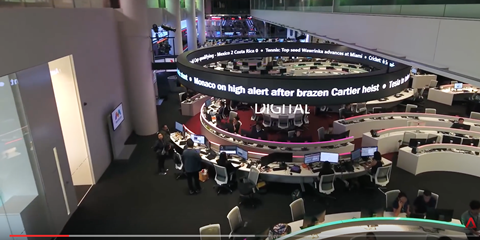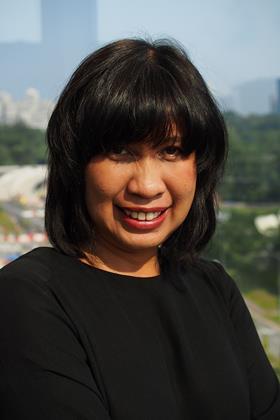IBC Innovation Awards finalist Mediacorp developed the state-of-the-art broadcasting centre simplifying operational workflows using interoperability and technology standards.
Leading broadcaster Mediacorp made the shortlist for implementing a service-oriented architecture to break down silos in its campuses around the world to create a seamless production and delivery environment.
Its new centre includes a 3,000 square metre newsroom producing online, television and radio news in four languages, together with six studios and a large theatre, more than 100 edit suites and OTT and broadcast delivery.
Mediacorp and Qvest Media, a leading systems architect and ICT integrator for broadcasting and media technology, have realised the overall planning of the new systems architecture, the tendering to identify the best performing solutions available on the market as well as the entire integration, training and commissioning of the broadcast infrastructure.

Mediacorp SVP Norraine Yusof explains:
What was the initial challenge: technical, creative or commercial?
With the move to our new Mediacorp campus, we didn’t just want to create a new home base for the company but also to innovate the future working environment for close to 3,000 staff. In addition, we needed to consider the changing consumer media consumption habits, as well as the rise of OTT, offers to better serve our stakeholders: audiences, advertisers, employees and the community at large.
In the former Mediacorp facility, content planning, production and distribution units often worked isolated from each other and were physically separated in different buildings.
Content sharing was a challenge with many different legacy systems used by the various production departments. So, we needed to fundamentally change our organisational structure and workflow management to achieve closer interoperability across all departments to be able to quickly produce, package and deliver high quality content and become a truly digital and future-oriented media company.
This was in line with our vision to move away from traditional media lines towards a focus on specific consumer segments and target audiences and providing them with relevant content regardless of the media platform. The overall system architecture needed to support this vision and to remain future-proof with the flexibility to adjust to changing market conditions.
How did you collaborate to find a solution? Talk us through the process and timeline
In 2011, Mediacorp started planning the move to the new campus in the heart of Mediapolis@One-North. At this point the new Mediacorp Campus was not even built yet and was in the early architectural design stage. In June 2013, Mediacorp appointed Qvest Media as our media consultant and master systems integrator following a tender process for the broadcast technology implementation program.
With Qvest Media on board, we started the overall planning of the new system architecture to define the technology design and rolled out the tendering process to select the best performing solutions in the market. Based on its long-standing expertise in the market, we entrusted Qvest Media to manage the tendering process at the technical level while Mediacorp maintained the commercial control.
Our strong collaboration with Qvest Media was essential for success when implementing the tendering process. We decided to follow a vendor-neutral approach for selecting best-of-breed solutions available in the market. The result was a roadmap of 74 different tenders for playout, transmission, IT networking, servers, managing application for content, post-production, radio and news systems, workflow orchestration and many more.
Together with Qvest Media, we evaluated the vendor proposals for the right combination of products and identified 42 vendors from 20 different countries across the world. In parallel, we planned the whole broadcast system in detail to prepare the overall installation and commissioning, bearing in mind that we needed to migrate and integrate existing facilities and to protect our recent investments at the old campus.
Installation and commissioning included acceptance and the on-air process and were managed jointly with Qvest Media – always in close collaboration with our Mediacorp Campus development team and all 42 vendors from across the world.
In Sept 2016, Mediacorp and Qvest Media started rolling out the training programmes for more than 1,000 staff members. After four years of intensive work, we launched our first official broadcast using the new infrastructure in November 2016 and progressively in stages until the move was completed in May 2017.
What challenges did you face when collaborating with the technical partners in order to develop a solution?
The major challenges laid within the overall planning and coordination with the 42 vendors based in 20 different countries around the world. In addition, we were looking for a technical design that not only allows the IT, AV, hardware and software solutions of the different business units to seamlessly and mutually communicate via a central integration layer – all despite having versatile technology standards from so many manufacturers.
At the same time, we needed to implement a modular approach to the system architecture, enabling technologies to be replaceable and reflect future innovations and market changes as needed.
Another major challenge was the emergence of cyber threats in our industry, which made network security a critical requirement for secure file transfers and exchanges.
Together with our consultant and systems integrator Qvest Media, we were able to master the challenges in close collaboration with the multiple system vendors by following a proven project methodology based on transparent decision-making, simple and straight-forward project communication and change management including the definition of regular milestones and ensuring predictable risk control.
What makes your project unique from your competitors?
The new 79,500 sqm Mediacorp Campus is one of the most modern broadcasting and media centre for digital, TV, radio and print in the APAC region.
In only 4 years, our teams at Mediacorp and Qvest Media realised this extensive project which also included the construction of a new campus building with a digital-first integrated newsroom as its centrepiece, a 1,500-seat broadcast-ready theatre, the relocation of all business divisions, as well as facilities migration for close to 3,000 staff – all while maintaining broadcasting operations during the migration period.
The move to the new campus with its well-designed physical work spaces and the state-of–the-art technology represents Mediacorp’s transformation to a media company for the digital age.
In order to establish Mediacorp’s new operational workflow structures across content production and delivery departments within the new campus, we needed to literally tear down silos and borders between production and distribution units.
A Service Orientated Architecture (SOA) and automated end-to-end file-based workflows now ensure seamless processing of the different business units via a central integration layer. The deep integration of all contribution and distribution environments allow our staff, such as journalists for TV, radio, news and online as well as technical operation teams from ingest to playout to work together and share resources across the whole campus.
All content silos have been removed and integrated into a common depository using an Enterprise Service Bus concept as an orchestration layer, enabling flexible file exchange at an operational level for all business units.
What is the benefit for viewers?
The new campus includes 6 TV studios as well as a 1,500-seat broadcast-ready theatre, 14 radio channels and production studios and about 100 editing and post-production stations, online distribution and OTT services, and the integration of the OOH as well as the press and publishing departments.
The “crown jewel” of the broadcast facility is an integrated multi-lingual newsroom on a single 3,000 sqm floor plate, supporting multiple platforms – digital, TV, radio and print – with 3 news studios featuring LED video walls and AR/VR technology as well as 4 additional flashcam positions that are embedded in the newsroom. The newsroom embraces a digital-first culture and is home to more than 600 journalists who break stories on the digital platforms first in 4 languages (English, Mandarin, Malay and Tamil) throughout the day and feed the traditional platforms at the same time.
For our viewers this means a platform-independent digital media consumption of target-group-specific content: From mobile devices to laptops or TV – our audience now has fast and easy access to the latest news and content – anywhere, anytime.
What lessons have you learned as a result of this project? Have they resulted in any changes to the way you approach future projects?
The way we approached this project was quite unique in the sense that there was no single systems integrator providing all the solutions with both technical and commercial responsibilities.
The decision to conduct the project this way was made early on to ensure Mediacorp remains in control legally and commercially as budget control was important to us. As a result of this approach, we were able to keep within the project budget allocated. However, there are challenges to this approach as Mediacorp then has to play a bigger role in administering the multiple tenders and managing the commercial obligations directly with over 40 sub-system vendors.
Another lesson learned for a project of this size and scale with specific technical requirements, is to bring in a media consultant on board at a much earlier stage to interface with the building contractors and architects. This would have resulted in fewer gaps in the communication and handling of critical technical infrastructure requirements for the broadcast and media systems.
Why is it important to participate in the IBC Innovation Awards?

Traditional broadcasting as we know it has changed forever. Consumers want to access content anywhere, at any time and on any device.
We need to start following an integrated approach in our industry – just as we did with our integrated newsroom: collaborate closely, embrace and promote the digital transformation and accept the change of perspective to further advance technologies, infrastructures and services.
Only if we can satisfy the needs of all our stakeholders, starting with the consumer at the centre of all our endeavours, are we able to make a difference in this fast-evolving sector.
The IBC Innovation Awards are so unique, as they highlight this close collaboration within our industry – regardless of the size and financial dimensions of the implemented projects – and thereby encourage the change in our industry through true creativity and innovation spirit.
IBC2017 Innovation Awards ceremony takes place Sunday 17 September
























No comments yet